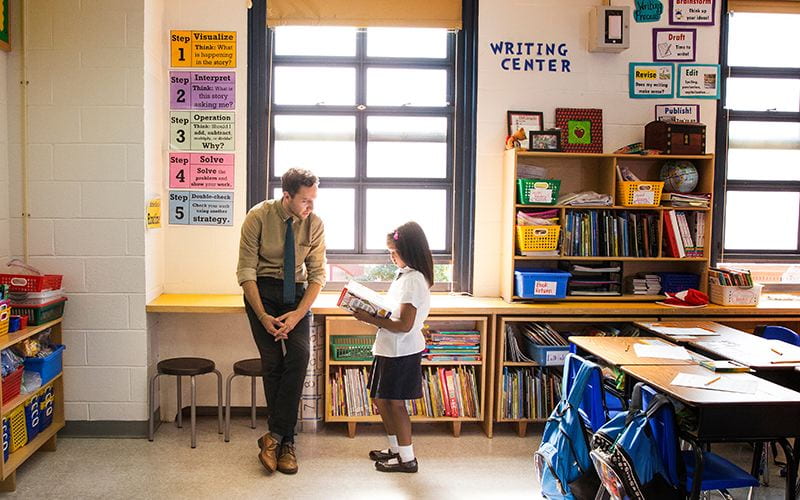England’s approach to teaching reading is too narrow
By Blog Editor, IOE Digital, on 11 October 2023

Credit: Cavan for Adobe
11 October 2023
By Dominic Wyse
This is the second of three blog posts about the teaching of phonics, reading and writing. The approach of this blog series is characterised as ‘A Balancing Act’.
- Understanding the PIRLS 2021 results;
- England’s narrow approach to phonics teaching;
- What works for phonics, reading and writing.
The Balancing Act: Part 2
In order to judge if England’s approach to teaching reading is narrow or not, we need a clear picture of what typically is happening in primary school classrooms. We also need a clear picture because some commentators may claim that England’s approach is not narrow. Although we lack large-scale independent evidence of observations in classrooms, by combining teacher survey data with the details of statutory policy and related requirements it is possible to identify aspects that are part of England’s approach.
The list below needs to be understood as a whole because it represents multiple policy levers that are used in tandem to enforce a single approach to teaching reading – essentially synthetic phonics (despite the government’s use of the descriptor ‘systematic synthetic phonics’):
- synthetic phonics begins at the latest in the Reception year (children aged 4 to 5), where, by law (Early Years Foundation Stage curriculum), a high stakes assessment requires all schools to test children on their ability to link a phoneme with each letter of the alphabet (this is an “Early Learning Goal” added in 2021);
- irrespective of whether children can read when they enter Year 1 (age 5 to 6), they must take part in all synthetic phonics lessons for at least two years, specified in great detail in the national curriculum and the reading framework;
- synthetic phonics must be prioritised, above all other aspects of reading, for at least two years of primary schooling (age 5 to 7) and continues to be emphasised in Year 3 for children with reading difficulties (age 7 to 8);
- children must be taught to decode words using phonics first and foremost rather than use meaning and syntax and the other words in the sentence (“context”);
- daily synthetic phonics lessons are separate from other reading lessons;
- ‘decodable books’ are preferred for use in phonics lessons; use of ‘real books’ in phonics lessons is discouraged;
- daily synthetic phonics lessons typically last between 45 and 60 minutes, irrespective of a child’s reading development;
- children are sometimes divided into ability groups based on synthetic phonics and sometimes sent to different classrooms and different teachers for their synthetic phonics lessons;
- the statutory high stakes test, the Phonics Screening Check, produces even more emphasis on synthetic phonics; this and other synthetic phonics pressures unbalance the curriculum in Year 1, and, for many children in Year 2;
- the presence of a government recommended list of commercial ‘systematic synthetic phonics’ schemes is a strong nudge – arguably much more than that in practice – for schools to work from one of those schemes, and has most likely has the effect of discouraging teachers from using their professional judgement in relation to different phonics and reading teaching methods;
- the cost of using such schemes will often include the expectation to purchase professional development sessions from the company selected, amounting to total costs of £10,000s for schools;
- the inspectorate, Ofsted enforces phonics requirements as part of the inspection of schools;
- synthetic phonics is enforced via government frameworks for initial teacher training.
And finally, it is advised that if children are assessed with reading difficulties, the solution is even more intensive synthetic phonics. Thus, England’s Department for Education’s approach is ‘synthetic phonics’ only: it strongly discourages other types of systematic phonics teaching, and does not allow any other approaches to teaching early reading, such as ‘balanced instruction’. I say more about this in part 3 of this blog series.
A key question remains whether the research evidence backs up this approach. The research evidence has been clear for many years that ‘systematic phonics’ approaches are one important part of learning to read – see, for example, my own 2008 review with Usha Goswami and the 2006 review by Torgerson et al for the then Department for Education and Skills. It has also been clear for many years that a range of approaches to systematic phonics are effective, not only synthetic phonics. The most relevant and robust research studies, including those covered by the 2022 Wyse and Bradbury paper, show effective phonics teaching that does not reflect the narrow approach currently enforced in England. So, the policy in England is not as good as it could be if it better reflected the evidence from existing ‘gold standard’ research. The need for further experimental trials on effective phonics teaching remains, but the curriculum policies in England mean it is probably not possible to undertake such research because schools may be fearful of deviating from the prescribed policies – another serious limitation caused by the policy context.
 Close
Close



